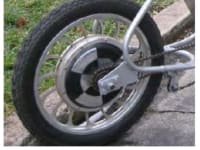This machine was researched, designed, and built to evaluate an NEV concept.
The availability of inexpensive E-Scooter components encouraged a baseline approach to designing a 3 wheeler E-Trike (2F1R) configuration for the purposes of evaluating an NEV in Canada's extreme climate. The 3 wheeler approach was chosen because of experience with a 2 wheeled E-Scooter's tendency to skid around on damp leaves and snow due to the high torque delivered by the BLDC Hub Motor. The Propulsion System is based around a 500 Watt Hub Motor integral with an 18”diameter wheel.
The original battery system was 48V12Ah. The second machine has a 48V25Ah system. Both systems are Sealed Lead Acid (SLA). Development to install Lithium Batteries (LiFePO4) has been temporarily shelved because of recent fires in the locality caused by Lithium batteries. An alternative development is the installation of ultra capacitors to capture more regenerative braking...this is a Work in Progress. (An advanced proprietary aluminum based battery system is also a Work in Progress on electrolyte configurations aimed at reducing gassing and corrosion of the aluminum anodes.)
A 500 Watt Hub Motor is driven via a controller which receives input from a twist grip on the right hand handlebar. The BLDC Motor (85%-93% efficiency) powering the single rear wheel delivers instant torque to the road which results in impressive acceleration. Torque input to the BLDC motor is conditioned via a controller which sets the maximum speed at 32 kph (20mph). This permits the vehicle to be used without a driving license, with no insurance requirements, and on bike paths. Pedal power must also be provided and a DOT approved helmet is mandatory (Ontario Regulations).
A steel tube based chassis structure (in the prototypes) uses a simplified design employing a minimum number of components to achieve a stable, fully sprung, 2 Wheels Forward 1 Wheel Rear (2F1R) configuration for the E-Trike. (Inset shows the Indy Car Suspension)The Electrical System is based around proven configurations which worked successfully in E-Scooters
It is proposed to improve the range by developing the ultra capacitor system capturing regenerative braking power. This will replenish the batteries via a DC to DC converter.
Road testing has been completed in Canada for all seasons.
Electrical costs (Ontario) for E-Trike recharging:-
11 km on a nickel (5c) of electricity
22 km on a dime (10c) of electricity
55 km on a quarter (25c) of electricity
Some work to provide weather protection is ongoing. Additions have been provided using modular components.
When the temperature drops (as in the fall) wind deflectors are the minimized installation, then local lightweight protection installed in 5 minutes takes care of rainy days. In winter lightweight insulated cowlings are installed.
Stability in snow is exceptional. The trike was deliberately fish tailed, yet the steering line was maintained under complete control by the operator
Like this entry?
-
About the Entrant
- Name:John Mitchell
- Type of entry:teamTeam members:Jim Grimwood of JRG TECHNOLOGIES
John Mitchell of MITCHELL RESEARCH - Software used for this entry:Rhino, SolidWorks, Scan 'n Solve
- Patent status:none








